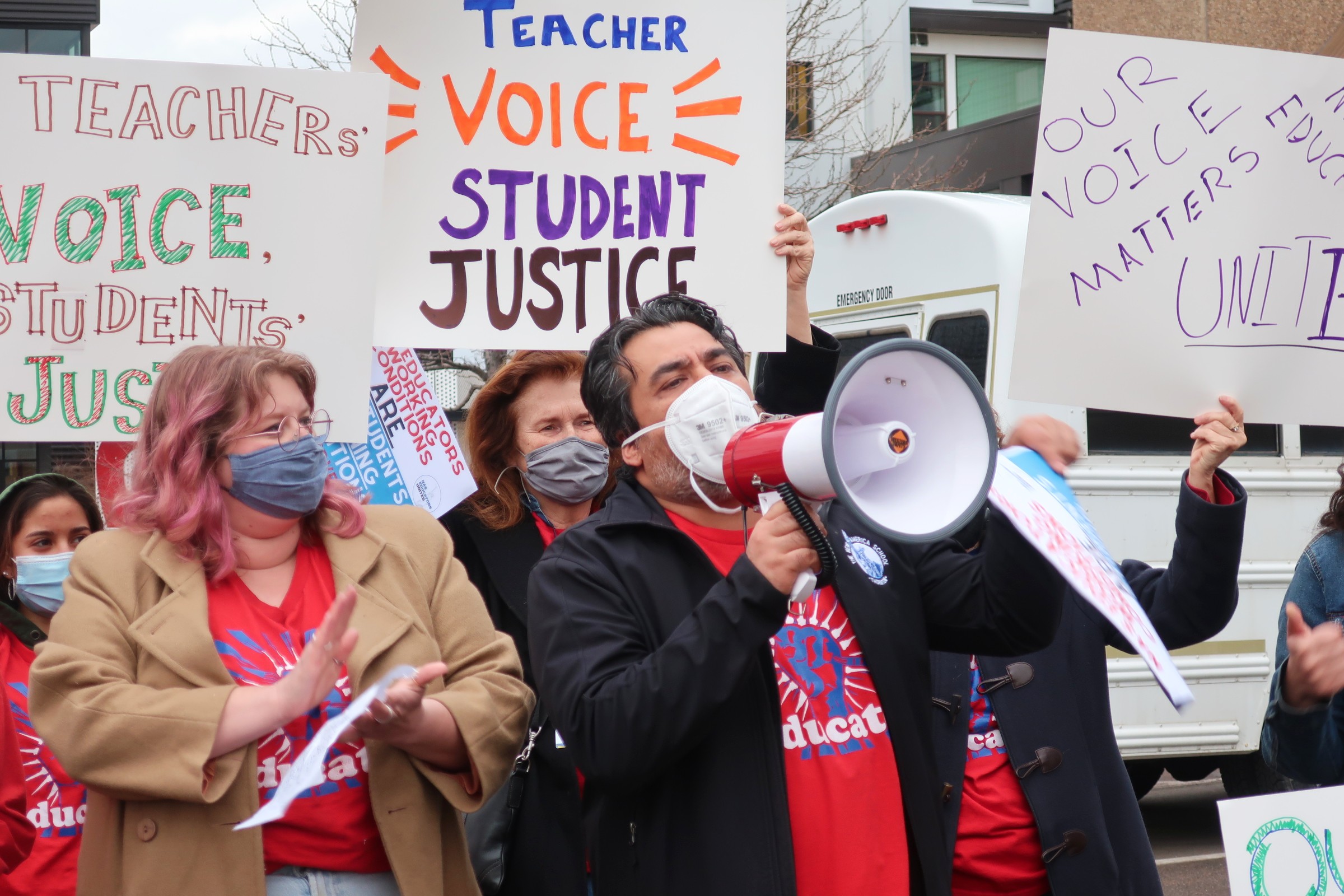
A group of Denver metro charter school teachers lost their bid to form a union on Wednesday after board members for The New America School system voted against their request for recognition, instead creating a committee to collect complaints.
If they’d been successful, the group, NAS Educators United, would have formed Colorado’s first public-sector union for charter school teachers. The group began organizing last year to address educator concerns about high faculty turnover and infrastructure issues at the system’s three campuses in Thornton, Lakewood and Aurora.
“I feel really un-listened to,” said Collette Simkins, a drama and art teacher at the system’s Thornton campus, following the vote. “These [board members] are not in our classrooms. So I don't know how they feel that they know what is best for us and for our students when the only time I see them outside of a board meeting is at graduation.”
NAS is one of more than 250 charter school systems in the state. It was founded in 2004 by now-governor Jared Polis and Denver-area education philanthropists with a focus on English language instruction for immigrant families, according to its website.
It now employs 22 educators and serves almost 500 students.
Teachers, along with current and former students, pleaded with the board to grant them union rights during Wednesday’s meeting.
Michaela Perez, who identified herself as a former student, expressed frustration with a “tense” relationship between faculty and administrators. After a teacher helped her create a course plan to graduate high school one year early, an administrator unexpectedly changed it and prevented her from finishing early, Perez said.
“The teachers were the ones truly protecting me,” she said, asking the board to approve educators’ union rights. “I just want my teachers to be protected.”
Unlike workers in the private sector, most of Colorado’s public sector employees, including teachers, must gain employer approval to officially unionize and engage in collective bargaining. The NAS educators submitted their request to the board last fall.
More than 75 percent of the system’s teachers supported the request, according to NAS Educators United.
Instead of offering union rights, the NAS board put forward a proposal Wednesday night to create a new collaborative committee aimed at addressing faculty and student concerns. The group would consist of teachers, students and parents from each one of the system’s campuses and will “report to the board regularly on specific topics throughout the year.”
Board members favor the idea because it is the most “inclusive solution” to hear community perspectives on the system’s issues, said Dan McMinimee, the NAS superintendent.
“[The union proposal] has created a divisive environment in some of our buildings because we have staff that do not support what is being put forward,” McMinimee said. “The board felt like [the committee] was the best possible model that included all voices rather than just a few.”
Pro-union teachers dislike the idea and have vowed to keep pursuing ways to gain recognition, with the goal of eventually forming a chapter associated with the Colorado Education Association, the state’s largest teacher’s union.
“We’re continuing to fight for collective bargaining,” Simkins, the drama teacher, said. “We feel that’s the only way to have real accountability and a continued voice for educators.”
The CEA also expressed disappointment in the NAS board’s vote on Wednesday.
“All workers, including teachers, should have the right to come together and form a union so their voices are heard,” said Amie Baca-Oehlert, CEA’s president in a statement. “NAS Educators United has done the work to sign on the vast majority of network teachers and it was crushing to see the NAS school board refuse to grant recognition of their union.”
Teachers’ top frustrations include unreliable internet access in some buildings, a lack of time to collaborate with other teachers on ways to support students and a “shockingly high” turnover rate, Simkins and other teachers said.
Almost 50 percent of teachers have quit in just the last six months, according to NAS Educators United. The school system currently has 8 vacant staff positions, including 6 faculty jobs.
The system’s campus in Aurora has struggled to provide reliable Wi-Fi for students, making it difficult for them to complete assignments.
McMinimee acknowledged the internet problems, but said it was due to the school moving into a new building during the summer of 2021.
“We just moved there this [school] year,” he said. “We're still learning how the building works.”
The teachers’ options remain limited. Earlier this year, top Democratic lawmakers in the legislature said that they wanted to guarantee collective bargaining rights for many more local government employees in Colorado, including teachers.
But that bill has yet to be introduced, and it likely won't include teachers when it finally is. Many district leaders and local governments have pushed back on the idea, arguing voters and elected officials should have the power to decide whether employees can unionize. Even Gov. Polis has expressed skepticism about the new law.
Today, only 15 of Colorado’s 272 municipalities have collectively bargained agreements with any part of their workforce, and almost all of those contracts are with police and firefighters. Just about a quarter of school districts have collective bargaining guarantees.
The NAS board’s vote on Wednesday officially puts the collaborative committee alternative “under study,” according to the board. Members will spend the next month gathering comments.
The board aims to bring the policy back to the table during its next meeting in May. A final draft will then go to schools for more feedback from students, parents and staff.
CPR’s Alejandro Alonso Galva and Andrew Kenney contributed reporting.









